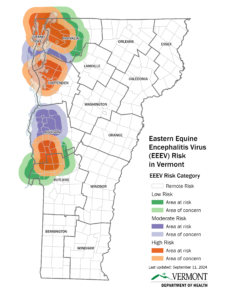A warning about moisquito-spread virus ‘EEE’

Throughout my writing career, I have never written news articles in the hopes to scare my readers.
I firmly believe that the readers’ thoughts and feelings should always come first in designing any type of writing. My writing is created for the sole purpose to inform you.
This article was created not to scare you, but to simply inform you about what is going on in the natural world, specifically the rare but dangerous Virus known as Eastern Equine Encephalitis.
This virus is also known as EEE and is zoonotic, meaning it can jump from non-human animal hosts to human hosts. EEE travels through the bite of an infected mosquito.
The Vermont Department of health states, “EEE virus typically infects birds, and in most years, it remains in bird populations, posing little danger to humans and horses. Mosquitoes become infected by feeding on infected birds. If an infected mosquito bites a horse, human or other susceptible animal, the animal or person can become sick. The virus that causes EEE is only spread by mosquitoes. People, horses and deer do not spread the disease.”
The Vermont Department of Health also explains that Eastern Equine Encephalitis commonly affects horses. However, other animals like pheasants, donkeys, alpacas and emus have also been known to carry it.
According to the state of Connecticut Mosquito Management Programs official site, “Most people infected with EEE virus do not become ill. When symptoms do occur, they can range from mild fever and headache to coma. Other symptoms include high fever, fatigue, muscle aches, neck stiffness, tremors, or confusion. Severe cases include inflammation of the brain (encephalitis) which can lead to coma, convulsions, and death.”
The state of Connecticut Mosquito Management Program’s official site also states that symptoms are likely to occur three to 10 days after an infected Mosquito bites a person.
Unfortunately, this disease also has no known cures. The state of Connecticut Mosquito Management Program’s site also gives insight on the vaccine for Eastern Equine Encephalitis.
“There is no cure for EEE, and three of every 10 people who get the disease die from it. Doctors provide supportive treatment, lower the fever, and ease the pressure on the brain and spinal cord. Some people who survive this disease will be permanently disabled and only about half recover completely.”
The site also states that the reason why there is no vaccine for Eastern Equine Encephalitis is because this virus occurs so infrequently in humans. The Vermont Department of health also gives information of the EEE virus in Vermont.
“EEE was first detected in Vermont in 2011. From July through mid-October, mosquitoes are collected from sites around the state and tested for EEE at the Health Department Laboratory. This season there have already been over 70 groups of mosquitoes that tested positive for EEE virus across more than 15 towns, compared with 14 groups across three towns that tested positive in 2023.
The Vermont Department of health also states that the high-risk towns include Alburgh, Burlington, Colchester, Sudbury, Swanton and Whiting Vermont.
“That the first human case of Eastern Equine Encephalitis in Vermont since 2012, was found in Chittenden County” the Vermont Department of Health site states. “The EEE virus activity in Vermont clusters near acidic, hardwood swamps, most commonly in Franklin, Grand Isle, Addison, and northern Rutland counties. However, EEE virus could be circulating in other parts of the state, so all Vermonters should take precautions to prevent mosquito bites.”
There are ways you can keep yourself and your family safe until the first hard frost comes to Vermont, which usually occurs between the third week of September and the first week of October, according to the National Weather Service.
The Vermont Department of Health strongly recommends “That people in towns at high risk avoid spending time outdoors as much as possible between 6 p.m. and 6 a.m. to avoid mosquitoes that could carry the virus. The recommendation will be in place until the first hard frost that kills mosquitoes.”
In addition, please make sure to wear long sleeves, and cover all parts of your skin when going outside especially at dawn or dusk. Also, avoid any still moving water sources outside, and try to avoid applying excessive perfumes or colognes.
I really hope that you are not scared or become paranoid by this article. My intent is not to scare you, but to inform and help you. We only have a couple more weeks until the first hard frost hits us, and we need to stay alert in the meantime. Please stay safe, and keep yourselves both mentally and physically healthy.








